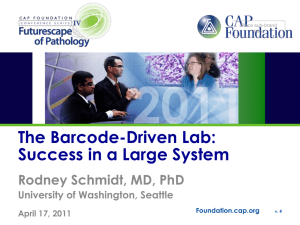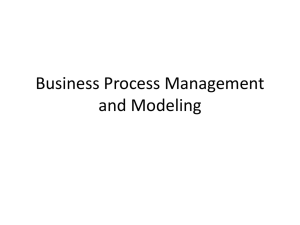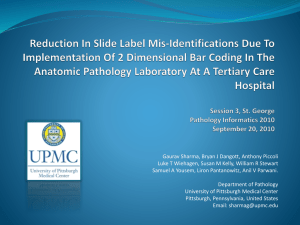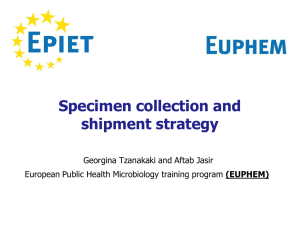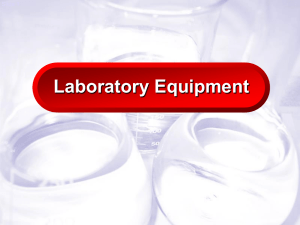Bar-coding in AP - Pathology Informatics 2015
advertisement
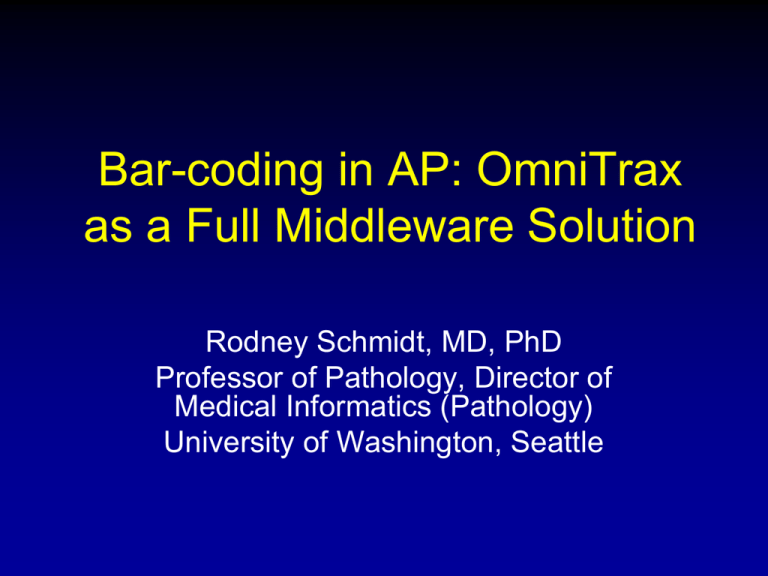
Bar-coding in AP: OmniTrax as a Full Middleware Solution Rodney Schmidt, MD, PhD Professor of Pathology, Director of Medical Informatics (Pathology) University of Washington, Seattle Today’s Story Lessons from OmniTrax – Lean processes and workflow – Deeper understanding of barcoding • Different levels of barcoding with different benefits – Measures of benefits • Quality and efficiency • Workflow dependent! – Current capabilities Trade-offs using a middleware solution Need for a bar-code standard Disclosure • Bar-coding software developed at UW (OmniTrax and OmniImage) has been licensed by UW to Pathway Pathology Consultants for PowerPath end-users. • Dr. Schmidt and his team have a revenue-sharing agreement with UW. • Dr. Schmidt has a consulting agreement with ThermoFisher for educational talks. • No other financial relationships with hardware or software manufacturers. Why barcode? • Expensive – $23k/gross station – $10k/cutting station – Software • Workspaces change – Wiring, networking • Time investment • Processes change – Material handling – QA • Jobs change – Workflow – Change management • Pathologists affected! – Software fast – Workspaces slow – Financing slow Who needs the hassle?! Why barcode? • Error reduction and patient safety – Errors labeling things – 1/300 (manual) to < 1/10,000,000 (datamatrix) • Reduced medical-legal liability • Custodial responsibility & inventory control • Self-interested reasons – Helps you do your job faster – Reduced time wasted on error resolution – Indirect efficiencies because of better knowledge about where things are What is Bar-coding? • Labeling – Putting barcodes on things – Technically easy, cheap (some methods) • Tracking – Location updates; inventory control – Added work; needs software; modest cost • Driving – Using barcodes to expedite workflow – Disruptive technology; expensive; LIS interoperability Bringing Bar-coding to AP • Track slides (2005) – Eliminate the “lost slide” problem – Ease conference prep • Specimen labels (2006) – Tissue discards and tracking – Drive gross photography • Block creation and labeling (2008) – Automated JIT production of barcoded blocks – Gross room QA process and tracking • Slide creation and labeling (2008) – Automated JIT creation of barcoded slides – Facilitate workflow and QA • Eliminate all manual labeling (and errors) • Facilitate workflow – JIT information display Achieved Benefits • Marked reduction in labeling errors • Improved inventory control (i.e. knowledge of where things are) • Direct savings of ~ 3 FTE • Indirect savings of >> 0.5 FTE • Improved image collection and management (paperwork, gross, micro, EMs, IF, etc) • Increased job satisfaction Bar-coding Options • Buy LIS-specific – Available? Capable? • Buy 3rd party solution (middleware) – Available? Capable? • Build LIS-specific middleware – Can be quick. Investment. • Build LIS-agnostic middleware – Most complex; most control Design Principles • No scanning without benefit – User acceptance; minimal training • No manual data entry – Eliminate human errors • Use barcodes to drive workflow – Efficiency • Make nothing until it’s needed – Eliminate handling and error opportunities • No assumptions – only trust scan events – Quality timestamps, locations, personnel • Leverage LIS • LIS-agnostic design Material identification (2005) • Handwritten specimen labels • Manual, offline cassette labeling • Hand-written slide labels Primary labeling errors (2004) 1000 900 800 700 600 500 400 300 200 100 0 ? Blocks Recorded Slides Actual Accession number is re-entered into a standalone cassette imprinter Targets – Gross Room • Foolproof labeling – No human labeling/data entry • Reduced dependence on support staff – Off-hours availability – Redirection of support personnel • Reduced waste of cassettes • Grossing step at least as fast as current • (Record timestamps) The unsupervised Resident! Targets - Accession Receive specimen and enter data into the LIS Generate a bar coded label for the specimen and laboratory request form. Minimum extra keystrokes (one) Classic Grossing Workflow Accession specimens Label specimens Label cassettes Group with specimens Move to staging area * * * Move to gross bench Lay out cassettes Fill cassettes * * Request more cassettes Store excess with specs Handling steps Rack filled cassettes Reconcile with LIS * Transport for processing * Possible errors * QA steps Just-in-Time Printing Accession specimens Bar-code specimens Fewer handling steps Fewer (1) error opportunities Scan/print cassettes Lay out cassettes Fill cassettes * * Fewer QA processes Courtesy General Data Rack filled cassettes * Transport for processing * Q&E Benefits “Classic” “Just-in-Time” Handling steps 11 5 Error opportunities 9 1 Manual QA steps 7 4 Primary labeling errors 988/yr (est.); (1.2%) 2 in 3 mo (initial); 0 in next 7 mo; (0.003%) Cassette wastage ~25/d (~7%) ~0 Grossing efficiency -- At least as fast Support staff -- 0.75+ FTE saved Histology – Embedding • Target – View critical information about block and specimen – Efficient workflow • Block scan: – Embedding instructions – Number of pieces of tissue – Specimen info – (Record timestamps) Histology – Cutting • Targets – Present critical information (block, specimen) – Eliminate manual slide labeling – Block/slide verification – Multiple workflows – No clutter – Efficient • Touch-screens; no keyboards • Block scan: – JIT slide printing/labeling – Info display • Slide scan: – Block/slide match Cutting - Benefits • Elimination of hand labeling • Much faster than manual labeling for blocks with many slides • Fewer block/slide mismatches • Overall throughput increased ~10% Slide Life Cycle Histology Pathology Offices Sendouts Faculty signout File Histology work order completes with scanning Pull for conference Ship Resident review Deliver Slides – Benefits • Less staff time looking for slides • Faster to find last location than make a phone call • Fewer arguments over whether slides were delivered • Fewer recuts? • Improved job satisfaction – ** Saved me 30 min the first day! ** • Overall savings > 2.0 FTE! Slides Benefits FTE Savings Histology +0.5 FTE Reduced time hunting for mis-delivered slides +0.5 FTE Auto completion of outstanding orders when slide is scanned Office staff +.5-1 FTE +.25 FTE Reduced time for conference preparation Increased efficiency regarding send outs Barcodes Enable… • Imaging – – – – Gross photos Photomics Documents EM/IF • Specimen management – Discards – Locations • Winscribe automation • HPV workflow – Reflex testing – Digene/Luminex Targets - Specimens • Discards – Accurate – Efficient – Documented • Track location • Drive photography Specimen Discard Workflow – Device scans specimen barcode – Handheld device queries AP-LIS • If case signout occurred <2wks prior • If case signout occurred >2wks prior • If note on Req Data tab, caution light and note display Barcoding Benefits • Direct personnel (FTE) – 2.0 – 0.75 – 0.1 – 0.1 – TBD Slide delivery and tracking Cassette printing Specimen discards Document scanning Fluorescence image import ~$150,000/yr assuming $50,000/FTE Barcoding Benefits • Indirect personnel (FTE) – 0.5 – TBD – TBD Scanned consult document availability1 Scanned Req forms Slide location info (e.g. Pathologists) • Reduced loss of materials – Slide/Block tracking – Specimen discards 1Schmidt, RA, et al. Am J Clin Pathol 126:678-83, 2006 Barcoding Benefits • Error Reduction – Elimination of all manual labeling steps! – Reduced labeling errors • Specimens • Blocks – ~988/yr to near 0 – “How did you manage to do that?!” • • • • Slides Gross photos Scanned documents Photomicrographs OmniTrax – What’s new? • Interface model for interacting with LIS • More customers – OHSU – NYU • HPV workflow implemented • Gross/Histo enhancements • (Cytology support) • (Immunostainer interfaces) – Leica Bond 3 – BioCare intelliPATH • (Archives tracking port) • (Slide tracking port) Middleware Software that bridges a human to one or more major systems Advantages • Leverage the power of core systems • Deliver niche functionality • Avoid duplication of core functions Disadvantages • Ongoing interoperability • If you build your own: Independence and control • LIS data model poor – – – – – Open hardware options Portability between LISs Short bug/fix cycle Implement functions you need Tune and refine prn – LIS upgrades – Might change LISs • Negotiate interfaces – Extract data – Write data – Too simple – Missing concepts • If you build your own: Ongoing support obligation Basic Architecture OmniTrax LIS Agent UI/ app UI/ app Agent Business objects Database UI/ app QA Reports Local Extensions OmniTrax UI/ app UI/ app UI/ app UI/ app Web app LIS Agent LIS Agent Agent Business objects Database IIS Web app Reports Reports Growth and Complexity as of Sept 7, 2010 • Lab Framework Client DLL – 22,850 lines (about 460 printed pages) • OmniTrax Server – 11,554 lines (about 235 pages) • Agent – 4199 lines (85 pages) • Gross Room Manager – 4754 lines (97 pages) • Histology Manager – 5133 lines (104 pages) • That’s equivalent to: Version 1: 22 tables – Les Miserables – All three Lord of the Rings books Version 4: 48 tables Need for a Standard Problems 1. Multiple barcodes from diff. facilities on same item 2. No “assigning authority” in barcode Interpreted differently by different software 3. Some proprietary uses APIII focus group suggestions (2008) 1. The barcode should contain only an identifier (e.g. “license plate”); software determines use 2. The barcode should contain something equivalent to an “assigning authority”. ID|application|installation 12356789|OmniTrax|UWPath98195 Why barcode? Expensive Workspaces change Process changes … true, but reasonable ROI … it might be time … new processes are better Jobs change … but more valuable activity Pathologists affected Time investment … in good ways … pays off! Better lab efficiency Error/liability reduction Inventory control Resident autonomy Gateway to more functions Acknowledgements • • • • • Phil Nguyen Kevin Fleming Rosy Changchien Chris Magnusson Victor Tobias • General Data • Thermo-Fisher • Accu-Place • • • • • • Dr. Erin Grimm Dan Luff Steve Rath Pam Selz Kim Simmons All the Techs and Office Folks!
